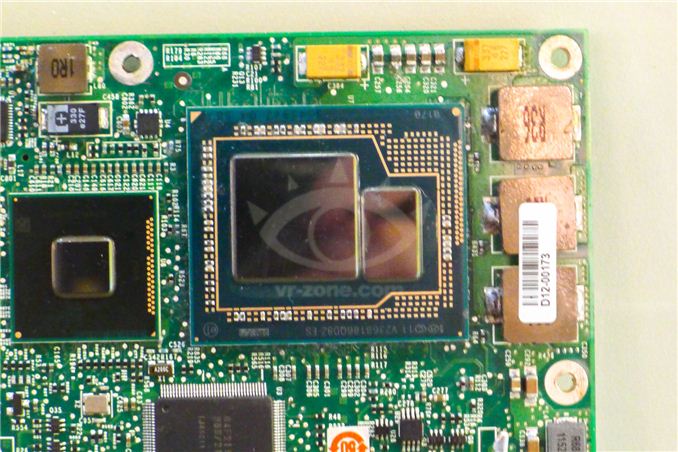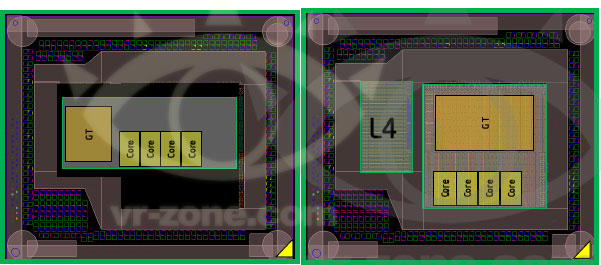Results 2,831 to 2,840 of 12091
Thread: Anandtech News
-
04-23-13, 08:30 AM #2831
Anandtech: Origin Genesis Review: Triple Titan Terror
At long last we're taking an in-depth look at Origin's latest generation Genesis desktop system. Backed by a heavily overclocked Core i7 processor and no less than 3 GeForce GTX Ttians, it is unquestionably among the fastest gaming PCs available today. Diving into Origin's powerhouse we'll see just what kind of performance such a machine can achieve, and how well GTX Titan scales out in a tri-SLI setup.
More...
-
04-23-13, 11:30 AM #2832
Anandtech: Intel's Return to DRAM: Haswell GT3e to Integrate 128MB eDRAM?
We've known for a while now that Intel will integrate some form of DRAM on-package for the absolute highest end GPU configurations of its upcoming Haswell SoC. Memory bandwidth is a very important enabler of GPU (and multi-core CPU) performance, but delivering enough of it typically required very high speed interfaces (read: high power) and/or very wide interfaces (read: large die areas). Neither of the traditional approaches to scaling memory bandwidth are low power or cost effective, which have kept them out of ultra mobile and integrated processor graphics.
The days of simple performance scaling by throwing more transistors at a design are quickly coming to an end. Moore's Law will continue but much like the reality check building low power silicon gave us a while ago, building high performance silicon will need some out of the box thinking going forward.
Dating back to Ivy Bridge (3rd gen Core/2012), Intel had plans to integrate some amount of DRAM onto the package in order to drive the performance of its processor graphics. Embedding DRAM onto the package adds cost and heat, and allegedly Paul Otellini wasn't willing to greenlight the production of a part that only Apple would use so it was canned. With Haswell, DRAM is back on the menu and this time it's actually going to come out. We've referred to the Haswell part with embedded DRAM as Haswell GT3e. The GT3 refers to the GPU configuration (40 EUs), while the lowercase e denotes embedded DRAM. Haswell GT3e will only be available in a BGA package (soldered-on, not socketed), and is only expected to appear alongside higher TDP (read: not Ultrabook) parts. The embedded DRAM will increase the thermal load of the SoC, although it shouldn't be as painful as including a discrete GPU + high speed DRAM. Intel's performance target for Haswell GT3e is NVIDIA's GeForce GT 650M.
What we don't know about GT3e is the type, size and speed of memory that Intel will integrate. Our old friend David Kanter at RealWorldTech presented a good thesis on the answers to those questions. Based on some sound logic and digging through the list of papers to be presented at the 2013 VLSI Technology Symposium in Kyoto, Kanter believes that the title of this soon to be presented Intel paper tells us everything we need to know:
"A 22nm High Performance Embedded DRAM SoC Technology Featuring Tri-Gate Transistors and MIMCAP COB"
According to Kanter's deductions (and somewhat validated by our own sources), Haswell GT3e should come equipped with 128MB of eDRAM connected to the main SoC via a 512-bit bus. Using eDRAM vs. commodity DDR3 makes sense as the former is easier to integrate into Intel's current fabs. There are also power, manufacturability and cost concerns as well that resulted in the creation of Intel's own DRAM design. The interface width is a bit suspect as that would require a fair amount of area at the edges of the Haswell die, but the main takeaway is that we're dealing with a parallel interface. Kanter estimates the bandwidth at roughly 64GB/s, not anywhere near high-end dGPU class but in the realm of what you can expect from a performance mainstream mobile GPU. At 22nm, Intel's eDRAM achieves a density of around 17.5Mbit/mm^2, which works out to be ~60mm^2 for the eDRAM itself. Add in any additional interface logic and Kanter estimates the total die area for the eDRAM component to be around 70 - 80mm^2. Intel is rumored to be charging $50 for the eDRAM adder on top of GT3, which would deliver very good margins for Intel. It's a sneaky play that allows Intel to capture more of the total system BoM (Bill of Materials) that would normally go to a discrete GPU company like NVIDIA, all while increasing utilization of their fabs.
Based on leaked documents, the embedded DRAM will act as a 4th level cache and should work to improve both CPU and GPU performance. In server environments, I can see embedded DRAM acting as a real boon to multi-core performance. The obvious fit in the client space is to improve GPU performance in games. At only 128MB I wouldn't expect high-end dGPU levels of performance, but we should see a substantial improvement compared to traditional processor graphics. Long term you can expect Intel to bring eDRAM into other designs. There's an obvious fit with its mobile SoCs, although there we're likely talking about something another 12 - 24 months out.
AMD is expected to integrate a GDDR5 memory controller in its future APUs, similar to what it has done with the PlayStation 4 SoC, as its attempt to solve the memory bandwidth problem for processor based graphics.
More...
-
04-23-13, 12:00 PM #2833
Anandtech: Intel's Return to DRAM: Haswell GT3e to Integrate 128MB eDRAM?
We've known for a while now that Intel will integrate some form of DRAM on-package for the absolute highest end GPU configurations of its upcoming Haswell SoC. Memory bandwidth is a very important enabler of GPU (and multi-core CPU) performance, but delivering enough of it typically required very high speed interfaces (read: high power) and/or very wide interfaces (read: large die areas). Neither of the traditional approaches to scaling memory bandwidth are low power or cost effective, which have kept them out of ultra mobile and integrated processor graphics.
The days of simple performance scaling by throwing more transistors at a design are quickly coming to an end. Moore's Law will continue but much like the reality check building low power silicon gave us a while ago, building high performance silicon will need some out of the box thinking going forward.
Dating back to Ivy Bridge (3rd gen Core/2012), Intel had plans to integrate some amount of DRAM onto the package in order to drive the performance of its processor graphics. Embedding DRAM onto the package adds cost and heat, and allegedly Paul Otellini wasn't willing to greenlight the production of a part that only Apple would use so it was canned. With Haswell, DRAM is back on the menu and this time it's actually going to come out. We've referred to the Haswell part with embedded DRAM as Haswell GT3e. The GT3 refers to the GPU configuration (40 EUs), while the lowercase e denotes embedded DRAM. Haswell GT3e will only be available in a BGA package (soldered-on, not socketed), and is only expected to appear alongside higher TDP (read: not Ultrabook) parts. The embedded DRAM will increase the thermal load of the SoC, although it shouldn't be as painful as including a discrete GPU + high speed DRAM. Intel's performance target for Haswell GT3e is NVIDIA's GeForce GT 650M.
What we don't know about GT3e is the type, size and speed of memory that Intel will integrate. Our old friend David Kanter at RealWorldTech presented a good thesis on the answers to those questions. Based on some sound logic and digging through the list of papers to be presented at the 2013 VLSI Technology Symposium in Kyoto, Kanter believes that the title of this soon to be presented Intel paper tells us everything we need to know:
"A 22nm High Performance Embedded DRAM SoC Technology Featuring Tri-Gate Transistors and MIMCAP COB"
According to Kanter's deductions (and somewhat validated by our own sources), Haswell GT3e should come equipped with 128MB of eDRAM connected to the main SoC via a 512-bit bus. Using eDRAM vs. commodity DDR3 makes sense as the former is easier to integrate into Intel's current fabs. There are also power, manufacturability and cost concerns as well that resulted in the creation of Intel's own DRAM design. The interface width is a bit suspect as that would require a fair amount of area at the edges of the Haswell die, but the main takeaway is that we're dealing with a parallel interface. Kanter estimates the bandwidth at roughly 64GB/s, not anywhere near high-end dGPU class but in the realm of what you can expect from a performance mainstream mobile GPU. At 22nm, Intel's eDRAM achieves a density of around 17.5Mbit/mm^2, which works out to be ~60mm^2 for the eDRAM itself. Add in any additional interface logic and Kanter estimates the total die area for the eDRAM component to be around 70 - 80mm^2. Intel is rumored to be charging $50 for the eDRAM adder on top of GT3, which would deliver very good margins for Intel. It's a sneaky play that allows Intel to capture more of the total system BoM (Bill of Materials) that would normally go to a discrete GPU company like NVIDIA, all while increasing utilization of their fabs. NVIDIA will still likely offer better perfoming solutions, not to mention the benefits of much stronger developer relations and a longer history of driver optimization. This is just the beginning however.
Based on leaked documents, the embedded DRAM will act as a 4th level cache and should work to improve both CPU and GPU performance. In server environments, I can see embedded DRAM acting as a real boon to multi-core performance. The obvious fit in the client space is to improve GPU performance in games. At only 128MB I wouldn't expect high-end dGPU levels of performance, but we should see a substantial improvement compared to traditional processor graphics. Long term you can expect Intel to bring eDRAM into other designs. There's an obvious fit with its mobile SoCs, although there we're likely talking about something another 12 - 24 months out.
AMD is expected to integrate a GDDR5 memory controller in its future APUs, similar to what it has done with the PlayStation 4 SoC, as its attempt to solve the memory bandwidth problem for processor based graphics.
More...
-
04-23-13, 05:00 PM #2834
Anandtech: NVIDIA R319 Series Beta Driver 320.00 Available
NVIDIA's driver numbering can be a bit of a mystery at times, but after the R313 Series that encompasses all version 313.x and 314.x releases, NVIDIA is jumping ahead to their R319 Series drivers. Naturally, that means the first beta release of R319 is...320.00. Like I said, it can be a bit confusing at times. The good news is that the drivers, as always, are available for desktops and laptops.
Windows XP and even Vista support look like they're finally starting to disappear, or at least they're not a high priority, so the current beta driver is only available for Windows 7 and 8 on laptops, in both 32-bit and 64-bit versions. Desktops on the other hand get the full set of support for everything from XP to Windows 8 in 32-bit and 64-bit form.
The big headliners for this series of drivers is that these are the "game ready" drivers for Dead Island: Riptide, Neverwinter, and Star Trek. NVIDIA is also listing performance improvements for single and SLI configurations for a variety of games, including Dirt: Showdown (up to 18%), Tomb Raider (up to 8%), and StarCraft II (up to 6%), though that's with a GTX 660 so your mileage may vary depending on your specific GPU. Other titles receiving performance tweaks include Sniper Elite V2, Metro 2033, Far Cry 3, Deus Ex: Human Revolution, F1 2012, Assassin's Creed III, Battlefield 3,and BioShock: Infinite.
The full list of driver download links is below. Thanks to reader SH SOTN for the heads up.
Laptops: Windows 7/8 64-bit
Laptops: Windows 7/8 32-bit
Desktops: Windows Vista/7/8 64-bit
Desktops: Windows Vista/7/8 32-bit
Desktops: Windows XP 64-bit
Desktops: Windows XP 32-bit
More...
-
04-23-13, 05:30 PM #2835
Anandtech: NVIDIA R319 Series Beta Driver 320.00 Available
NVIDIA's driver numbering can be a bit of a mystery at times, but after the R313 Series that encompasses all version 313.x and 314.x releases, NVIDIA is jumping ahead to their R319 Series drivers. Naturally, that means the first beta release of R319 is...320.00. Like I said, it can be a bit confusing at times. The good news is that the drivers as usual are available for all recent desktop and laptop GPUs.
OS support is a bit of a change from some releases. Windows XP and even Vista support look like they're finally starting to disappear, or at least they're not a high priority, so the current beta driver is only available for Windows 7 and 8 on laptops, in both 32-bit and 64-bit versions. Desktops on the other hand get the full set of support for everything from XP to Windows 8 in 32-bit and 64-bit form.
The big headliners for this series of drivers is that these are the "game ready" drivers for Dead Island: Riptide, Neverwinter, and Star Trek. NVIDIA is also listing performance improvements for single and SLI configurations for a variety of games, including Dirt: Showdown (up to 18%), Tomb Raider (up to 8%), and StarCraft II (up to 6%), though that's with a GTX 660 so your mileage may vary depending on your specific GPU. Other titles receiving performance tweaks include Sniper Elite V2, Metro 2033, Far Cry 3, Deus Ex: Human Revolution, F1 2012, Assassin's Creed III, Battlefield 3,and BioShock: Infinite.
The full list of driver download links is below. Thanks to reader SH SOTN for the heads up.
Laptops: Windows 7/8 64-bit
Laptops: Windows 7/8 32-bit
Desktops: Windows Vista/7/8 64-bit
Desktops: Windows Vista/7/8 32-bit
Desktops: Windows XP 64-bit
Desktops: Windows XP 32-bit
More...
-
04-23-13, 11:30 PM #2836
Anandtech: AMD Radeon HD 7990 Review: 7990 Gets Official
Launching today and shipping in two weeks, the Radeon HD 7990 is AMD's official dual-GPU card for the Southern Islands family. Based on the same Tahiti GPUs that power the rest of the 7900 series, the 7990 seeks to pack most of the performance of a 7970 CrossFire setup into a single card. Though this isn't the first 7990 card to be launched, as we'll see it may just be the finest one yet.
More...
-
04-24-13, 04:30 AM #2837
Anandtech: Samsung Galaxy S 4 Review
It’s no secret that Samsung enjoyed huge success with Galaxy S 3. In many markets, SGS3 was easily the Android handset to beat, even as faster and arguably better hardware became available during the life of its product cycle. Samsung nailed the branding, marketing, and consistency battles with its third generation of Galaxy smartphone, and now we’re a year later and facing down SGS4.
There's always that question about how you follow up something that was wildly successful with another product, and carry over what was good about the previous generation that made it successful. There's no denying that Samsung is in an interesting position here, facing opposition from players desperate to get more market share against the now well-established player that is Samsung. At the same time Galaxy S 4 is by very name an iterative product. How does SGS4 stack up? Read on to find out.
More...
-
04-24-13, 05:00 AM #2838
Anandtech: Samsung Galaxy S 4 Review - Part 1
It’s no secret that Samsung enjoyed huge success with Galaxy S 3. In many markets, SGS3 was easily the Android handset to beat, even as faster and arguably better hardware became available during the life of its product cycle. Samsung nailed the branding, marketing, and consistency battles with its third generation of Galaxy smartphone, and now we’re a year later and facing down SGS4.
There's always that question about how you follow up something that was wildly successful with another product, and carry over what was good about the previous generation that made it successful. There's no denying that Samsung is in an interesting position here, facing opposition from players desperate to get more market share against the now well-established player that is Samsung. At the same time Galaxy S 4 is by very name an iterative product. How does SGS4 stack up? Read on to find out.
More...
-
04-25-13, 04:30 AM #2839
Anandtech: Capsule Impressions: The Stinky Footboard
Every so often an oddball peripheral or product comes around and your attention is demanded, but with the Stinky Footboard I felt unusually torn. As a gamer I'm an incredibly simple creature: I may assign extra functions to my mice, but I usually don't use them. There are eighteen programmable keys on my Corsair Vengeance K90 keyboard, but of those keys I use...one, which is assigned to a script that toggles Aero on and off. Peripherals are funny things, though, and a feature that one person may have no use for could be extremely desirable to another. A good friend and I both really like the Logitech G500 (and now the G500s); he liked the adjustable weight and didn't care about the freewheel, I loved the freewheel and didn't care about the adjustable weight. So it goes.
And then, every so often, something really unusual comes around. Submitted for your approval, the Stinky Footboard:
Essentially the footboard is as it says; there are four switches in a cross formation, and the board is designed to be used longways, with your foot stretching between the two LED points. Tension can be adjusted on the underside of the board, and they even include different springs so you can manually change the tension within the board. From there you just plug in the board using a conventional mini-USB 2.0 cable and install the lightweight software. Each of the four actuators is assigned a different keystroke, and you're off.
Credit where credit is due, the designers of the Stinky Footboard at least did right on the software side. This is a simple peripheral that demands a simple interface, so there's no reason for the software to be bloated. As for how it works in a more practical sense? That's trickier.
As far as I can tell, the build quality is good, the software side is good, so the pieces of a good experience are at least in play. In practice, though?
Designing a good user experience is an insanely tricky prospect. In my estimation, when you're considering whether or not something is intuitive, you're actually looking at two different types of intuition. The first is intuition within a vacuum: assuming no prior experience with something, how easy is it to figure out, does it work the way you'd hope or expect it to. The second is intuition through experience: you have experience with a particular action, maybe a particular piece of software, so even if that action or software isn't intuitive in a vacuum, you learned how to use it. This second type is where Microsoft tripped up tremendously with Windows 8; there weren't any breadcrumbs leading to the new user experience, it simply came into being, and thus people who were used to the Windows desktop and used to certain things being in certain places are suddenly completely baffled. Confusion frustrates.
By the same token, the Stinky Footboard is a fantastic idea in a vacuum that takes some serious getting used to in practice. I can see some users making the jump, but as someone who can't rub his stomach and tap the top of his head at the same time, I found I used it as a glorified pedal. The idea that our feet, which ordinarily hang uselessly beneath us, could be used to hit additional keys as needed is a sound one in theory. I can't be the arbiter of whether or not this is a good peripheral for everyone due to the very subjective nature of peripherals, but I found the Footboard complicated my gaming experience more than it enhanced it.
As a sidenote, while I was enamored with the concept I did find myself pretty severely put off by the branding. I'm not a foot fetishist nor do I harbor any illusions about the kind of funk that seeks refuge in my nether digits, but the cheeky branding and the idea that I'm going to rub my filth-infested hooves all over a peripheral was incredibly unappealing. I don't have a problem stepping on a peripheral, I play Dance Dance Revolution (badly) in the comfort of my own home whenever my living room isn't overflowing with cases, I just don't like my hardware tacitly acknowledging that my feet are raunchy.
Undoubtedly part of the reason the Footboard came our way was because it's being Kickstarted with a few days to go. My experience with it hasn't been super positive, but the times where I've felt like I was shy keys for whatever I wanted to play have been rare enough that I can't really see myself training myself to use both hands plus my foot. If it seems like something that might work for you, though, no harm in helping out with the Kickstarter. Fair warning, though: minimum pledge to actually get a Footboard is a not insubstantial $89.
More...
-
Thread Information
Users Browsing this Thread
There are currently 25 users browsing this thread. (0 members and 25 guests)





 Quote
Quote



.jpg)

















Bookmarks